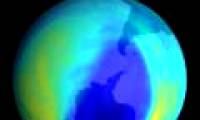
Unusual warming and a strange polar vortex this year have changed the cycle of the ozone hole. Don't celebrate too soon, scientists warn.

11 scientists were honored for pioneering research related to high-yield rice varieties, the hole in the ozone layer, solar cells, Lithium-ion battery storage, and diabetes and

The ozone layer above the Antarctic is continuing to recover and it has led to changes in the atmospheric circulation - airflow on the Earth's surface that causes wind.

An asteroid falling into the Pacific Ocean stimulates a large amount of evaporated seawater, thereby creating an ozone gap.

The ozone gap formed in Antarctica in September this year is the smallest sized hole monitored by scientists since 1988.

A recent study shows that the ozone layer in the Antarctic is beginning to shrink.

Scientists say that the ozone layer is gradually shrinking and may disappear by 2070.

In recent months, many regions in Vietnam and the world are constantly experiencing prolonged heat and drought, making us think of the global warming of the greenhouse effect.

Xinhua quoted Geir Braathen, a WMO expert, saying that in the past decade, the stratospheric ozone layer in the Arctic and Antarctic regions as well as globally has not decreased

Review the memorable events that took place on 9/9 in history.
 Unusual warming and a strange polar vortex this year have changed the cycle of the ozone hole. Don't celebrate too soon, scientists warn.
Unusual warming and a strange polar vortex this year have changed the cycle of the ozone hole. Don't celebrate too soon, scientists warn. 11 scientists were honored for pioneering research related to high-yield rice varieties, the hole in the ozone layer, solar cells, Lithium-ion battery storage, and diabetes and
11 scientists were honored for pioneering research related to high-yield rice varieties, the hole in the ozone layer, solar cells, Lithium-ion battery storage, and diabetes and The ozone layer above the Antarctic is continuing to recover and it has led to changes in the atmospheric circulation - airflow on the Earth's surface that causes wind.
The ozone layer above the Antarctic is continuing to recover and it has led to changes in the atmospheric circulation - airflow on the Earth's surface that causes wind. An asteroid falling into the Pacific Ocean stimulates a large amount of evaporated seawater, thereby creating an ozone gap.
An asteroid falling into the Pacific Ocean stimulates a large amount of evaporated seawater, thereby creating an ozone gap. The ozone gap formed in Antarctica in September this year is the smallest sized hole monitored by scientists since 1988.
The ozone gap formed in Antarctica in September this year is the smallest sized hole monitored by scientists since 1988. A recent study shows that the ozone layer in the Antarctic is beginning to shrink.
A recent study shows that the ozone layer in the Antarctic is beginning to shrink. Scientists say that the ozone layer is gradually shrinking and may disappear by 2070.
Scientists say that the ozone layer is gradually shrinking and may disappear by 2070. In recent months, many regions in Vietnam and the world are constantly experiencing prolonged heat and drought, making us think of the global warming of the greenhouse effect.
In recent months, many regions in Vietnam and the world are constantly experiencing prolonged heat and drought, making us think of the global warming of the greenhouse effect. Xinhua quoted Geir Braathen, a WMO expert, saying that in the past decade, the stratospheric ozone layer in the Arctic and Antarctic regions as well as globally has not decreased
Xinhua quoted Geir Braathen, a WMO expert, saying that in the past decade, the stratospheric ozone layer in the Arctic and Antarctic regions as well as globally has not decreased Review the memorable events that took place on 9/9 in history.
Review the memorable events that took place on 9/9 in history.









 Why do images of black holes appear to be burning from the outside?
Why do images of black holes appear to be burning from the outside? Researchers discover first 'conjoined' twin planets in the universe
Researchers discover first 'conjoined' twin planets in the universe Satellite launch to help... take selfies in space
Satellite launch to help... take selfies in space Why do most people with ALS not live more than 5 years, but Hawking lived to be 55?
Why do most people with ALS not live more than 5 years, but Hawking lived to be 55? Chilling revelations from 1,800-year-old glass 'treasure' in Antarctica
Chilling revelations from 1,800-year-old glass 'treasure' in Antarctica The sofa problem that has puzzled science for 6 decades has been solved
The sofa problem that has puzzled science for 6 decades has been solved Sad Eyes of the Ocean: The Story Behind the Stunning Beauty!
Sad Eyes of the Ocean: The Story Behind the Stunning Beauty! What happens if a star explodes near Earth?
What happens if a star explodes near Earth?